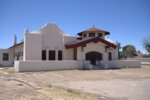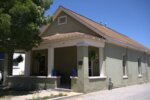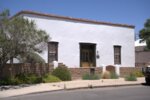Wind: 3.5 mph, N
Welcome to our new web site!
To give our readers a chance to experience all that our new website has to offer, we have made all content freely avaiable, through October 1, 2018.
During this time, print and digital subscribers will not need to log in to view our stories or e-editions.



History is all around us in Las Cruces. If you live or work in one of the older parts of town, eat in one of the fine restaurants or visit the shops, parks or art galleries in these areas, you have been surrounded by the places where history happened and where our unique culture developed. The importance of our local history was reinforced with the proclamation by the Las Cruces City Council that May is Historic Preservation Month. In addition, the city has begun officially recognizing and honoring these places with the Las Cruces Register of Cultural Properties.
If you walk down Mesquite Street in the Mesquite Historic District, El Camino Real is right under your feet. You are walking where, for 300 years, traders, Indigenous peoples, soldiers, settlers and monks walked, rode their horses and drove their oxen between Mexico City and Santa Fe. You can almost feel their presence beside you; almost hear their horses’ hooves, the oxen grunt and calls of greetings or warnings.
Great-great grandchildren of the settlers still live in the adobe homes of their ancestors and carry on family history and traditions. The Native American youth of the Piro, Manso, Tiwa pueblos still dance at the yearly religious ceremonies. Klein Park is a focal point of community gathering from large-scale events to community youth groups practicing T-ball and ballet folklorico.
Several neighborhood groups use the park for yearly events. One group has revitalized the Pachanga, a traditional Mexican festival that was very popular in the 1950s, then called Fiesta de Las Cruces. They have kept the foods, arts and crafts, games that are part of the traditions and added a lowrider car show that draws thousands of visitors. Another group holds a Winterfest with Santa and Mrs. Claus distributing goods to the local children and youth.
Main Street was the heart of the city from 1849 until the mid-1960s. It was the place where the community came to shop, eat, socialize, and have concerts, dances and plays on the plaza of St. Genevieve’s Catholic Church. The elders of the neighborhood would meet daily to discuss the “affairs of the world” and watch the people and cars go by. In the 1960s it was the site of the first play by the Las Cruces Community Theatre. You could gather at the post office, pay your utility bills at City Hall, have a soda and hamburger, go to the movies at the Rio Grande, State, or Plaza theatres or buy the latest fashion. There was always something to do on Main Street or downtown for community members of all ages and cultural backgrounds.
High-style buildings, like the impressive Judge H. B. Holt home, a Trost-designed Mission Revival house on Alameda Boulevard, are culturally significant as much for their design as for who lived there. But at least as significant are the vernacular adobe buildings that are the still-existing embodiment of a tradition that continues today.
Some are associated with individuals who, for better or worse, left a mark on their times. A modest bungalow on South Miranda Street was once home to one of New Mexico’s first U.S. senators and later secretary of the U.S. Department of the Interior in the Harding administration, Albert Bacon Fall. Unfortunately, he was also the first person holding a cabinet position to be convicted of a felony after accepting bribes from private oil interests in the infamous Teapot Dome Scandal.
A neat, white plastered, four-square adobe on West Griggs Avenue once housed Sam Bean, Jr. whose brother, Judge Roy Bean, was the famous “Law West of the Pecos.”
The city Historic Preservation Commission has established the Las Cruces Register of Cultural Properties, which recognizes not only buildings, but places such as parks or sites where any of the many different groups of people who make up the rich culture of Las Cruces carry on traditional activities. Inclusion on this register honors these places and buildings for either or both their historical and cultural contributions.
Anyone can propose a nomination for a site worthy of recognition, although the owners of the property must always give their permission. Forms can be obtained from the city Community Development Department at 575-528-3059. From there you can be directed to the city preservation specialist, Troy Ainsworth, who will provide information and advice on probable eligibility and filling out the form. Or you may contact him directly at 575-528-3027 or tainsworth@las-cruces.org. If you live or work in a historic or traditionally built building or know of a culturally significant place, consider talking with Troy. He will help you decide if you wish to pursue it.
Benefits of listing in the Las Cruces Register of Cultural Properties:
Misconceptions of listing your property on a historic register:
Judy Berryman is chair of the City of Las Cruces Historic Preservation Commission. Sandra L. Marshall was the commission’s first chair.